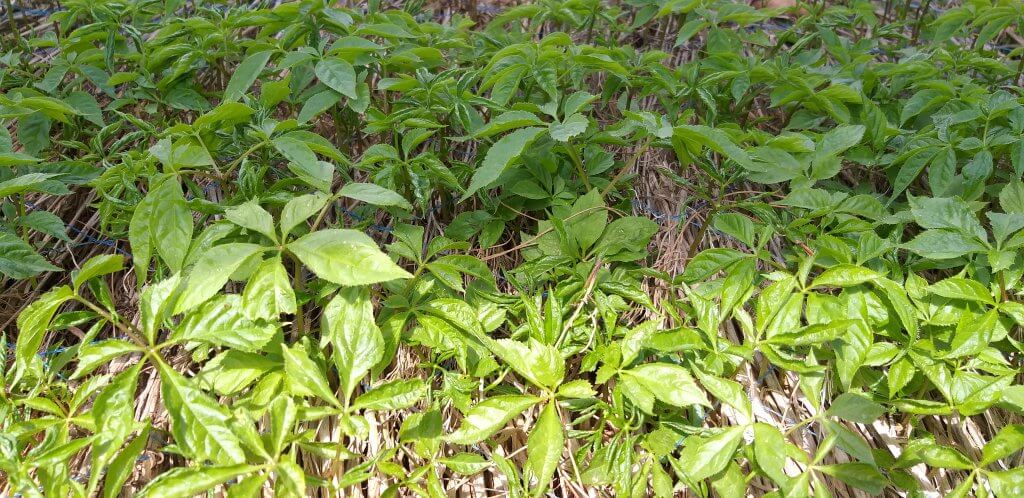Title and Common name:
Ginseng is a highly beneficial root and an effective one at that. Forming up the Genus Panax there are many variants of Ginseng present throughout the corners of the earth.
Scientific name plus an introduction:
The types include an American Variant (Panax Quinquefolius), the Korean variant (Panax Ginseng), a Chinese Variant (Panax Notoginsang) but it doesn’t stop there even Vietnam has its own kind of Ginseng (Panax Vietnamensis). Many have long regarded it as a potent medicinal herb. Various health care products including Herbal Teas, Medicines (including weight loss) plus Sports drinks include ginseng in their ingredients.

Distribution of Ginseng:
People have caused the distribution of Ginseng throughout various countries in the world. These parts include North and Southwest of China, the eastern part of Russia, Vietnam, Korea (North and South both) and America.
Cultivation History of Ginseng:
We have cultivated ginseng all over the world, from the Far East to the west. On rough mountainous it hold its roots, roots that depict a story of centuries of arduous cultivation. Subsequently, because of its significance within in traditional medicine, it has been harvested by eastern cultures but is now gaining importance in the west gradually.
Types of Ginseng based on cultivation methods:
There are two principle fundamental types of Ginseng. The first one being the Wild form of Ginseng and the second one being the cultivated form of Ginseng. We’ll talk about the cultivated form of Ginseng First.
- Cultivated Ginseng:
- As the name implies we grow ginseng via general cultivation methods. Because of this, it without a doubt lacks the potency present in its wild brethren, ergo the cut in price. It can be called a far cry from the real McCoy; yet does what it’s supposed to in terms of medicinal benefits, just not as good as the Wild one.
- Wild Ginseng:
- The far superior cousin (as stated by those who use it) of the cultivated Ginseng variant; it grows in the hard mountain regions of the globe. The price of a wild Ginseng root varies from a couple hundred to even thousands of dollars; adding more to why it holds great value. Harvested by hand it is a peculiar novelty; to which the most enthusiastic about its wild flavor can attest to. Endangered throughout the world and unfortunately stated to be extinct in China. Therefore, one can call Wild Ginseng a dwindling yet precious commodity while others might strive to preserve its kind for future generations to savor. For now, we can’t tell, but hopefully it will survive within the coming ages and might thrive beyond the current state that it is in now. Wild Ginseng also comes in two kinds; White Wild Ginseng and Red Wild Ginseng.
Benefits of Ginseng:
Ginseng has a vast plethora of benefits listed down below.
- Rejuvenates and re-energizes:
First, studies have shown that Ginseng relieves people. These forms various forms of fatigue include both mental and physical. This can be a reason ginseng is a common ingredient of energy drinks. - Presence of Anti-oxidants:
Ginseng improves the production and preservation of healthy cells via enhancing anti-oxidation affects the body which counteracts oxidation (a well-known process that deteriorates cells through time). - The ability to improve cognitive function:
Coupled with the healing effect of Anti-Oxidants, Ginseng preserves your brain cells, thus preventing brain damage incurred over time from various factors. It can be a crucial tool for preventing brain degenerative diseases like Alzheimer’s.
- Might decrease amount of sugar in your blood:
Various studies have also shown that when diabetic patients took ginseng in addition with their meals and assorted medicine. Eventually their blood sugar would stabilize at a better rate than it would ever before, which added to ginseng’s credibility as a medicinal herb/root.
Dosage and Safety:
- We should note that there are no mentioned adverse side effects of taking ginseng. However, as advised, always take a prescribed amount of ginseng.
- According to various recommendations, children and women who are expecting should steer clear of ginseng.
- Diabetics should regularly check their blood sugar level to see that it fluctuates that much.
- Last, a rule of thumb is to that you should take ginseng but with moderation. In addition, wait until the desired effects take place. Time and patience is of the utmost importance.
Conclusion:
Finally, ginseng is an old and tested remedy that holds potential cures we cannot yet fathom. Taken in the right amount and with the proper mindset, it can do wonders.
—————————————————————————————————————-
| Written By Muhammad Waleed Raja,
~ Waleed is an avid graphic designer, animator, illustrator as well as freelance writer with an affinity towards nature, art, technology and everything that encompasses gaming along with pop-culture added into the mix. To learn more about him look up his profile on upwork.com ~
—————————————————————————————————————-
Many of our readers find that subscribing to Eat The Planet is the best way to make sure they don't miss any of our valuable information about wild edibles.
See our privacy policy for more information about ads on this site






